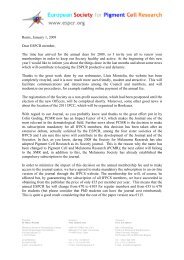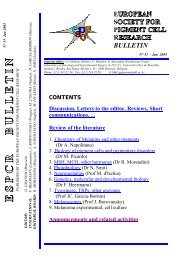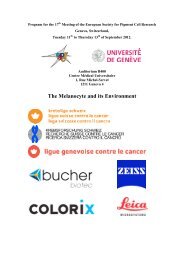espcrbulletin - European Society for Pigment Cell Research
espcrbulletin - European Society for Pigment Cell Research
espcrbulletin - European Society for Pigment Cell Research
Create successful ePaper yourself
Turn your PDF publications into a flip-book with our unique Google optimized e-Paper software.
- Lin WP, Lai HL, Liu YL, Chiung YM, Shiau CY, Han JM, Yang CM, Liu YT.<br />
Effect of melanin produced by a recombinant Escherichia coli on antibacterial activity of<br />
antibiotics. J Microbiol Immunol Infect. 38(5):320-6, 2005.<br />
A recombinant plasmid, pYL-1, containing a tyrosinase gene whose expression is under the control<br />
of a phage T5 promoter and 2 lac operators, was constructed. Escherichia coli JM109 harboring<br />
pYL-1 was used <strong>for</strong> production of bacterial melanin. A simple procedure <strong>for</strong> the isolation and<br />
purification of melanin was developed. The ultraviolet (UV)-visible light absorption spectra of<br />
melanin prepared by chemical synthesis and derived from different organisms, including bacteria, a<br />
plant and an animal source, were determined. Melanins produced by both bacteria and chemical<br />
synthesis showed a steady increase of absorption at wavelengths of UV light ranging from<br />
approximately 200-400 nm, while melanin derived either from plant or animal sources showed an<br />
additional discrete absorption peak at wavelength 280 nm upon a similar steady increase of<br />
absorption. This additional absorption peak could be due to the presence of protein-bound melanins<br />
in animal and plant sources while a free <strong>for</strong>m of melanin was obtained from bacteria and chemical<br />
synthesis. Analysis of the effect of bacterial melanin on the activity of antibiotics against E. coli<br />
revealed that the activities of polymyxin B, kanamycin, tetracycline, and ampicillin were markedly<br />
reduced in the presence of melanin, whereas the activity of norfloxacin was not affected. The<br />
reduction of the antibacterial activity may result directly from the interaction of antibiotics with<br />
melanin. However, the mechanism of this interaction remains to be demonstrated.<br />
- Lyons LA, Foe IT, Rah HC, Grahn RA.<br />
Chocolate coated cats: TYRP1 mutations <strong>for</strong> brown color in domestic cats. Mamm Genome.<br />
16(5):356-66, 2005.<br />
Brown coat color phenotypes caused by mutations in tyrosinase-related protein-1 (TYRP1) are<br />
recognized in many mammals. Brown variations are also recognized in the domestic cat, but the<br />
causative mutations are unknown. In cats, Brown, B, has a suggested allelic series, B > b > b1. The<br />
B allele is normal wild-type black coloration. Cats with the brown variation genotypes, bb or bb1,<br />
are supposedly phenotypically chocolate (aka chestnut) and the light brown genotype, b1b1, are<br />
supposedly phenotypically cinnamon (aka red). The complete coding sequence of feline TYRP1<br />
and a portion of the 5' UTR was analyzed by direct sequencing of genomic DNA of wild-type and<br />
brown color variant cats. Sixteen single nucleotide polymorphisms (SNPs) were identified. Eight<br />
SNPs were in the coding regions, six are silent mutations. Two exon 2 on mutations cause amino<br />
acid changes. The C to T nonsense mutation at position 298 causes an arginine at amino acid 100<br />
to be replaced by the opal (UGA) stop codon. This mutation is consistent with the cinnamon<br />
phenotype and is the putative light brown, b1, mutation. An intron 6 mutation that potentially<br />
disrupts the exon 6 downstream splice-donor recognition site is associated with the chocolate<br />
phenotype and is the putative brown, b, mutation. The allelic series was confirmed by segregation<br />
and sequence analyses. Three microsatellite makers had significant linkage to the brown phenotype<br />
and two <strong>for</strong> the TYRP1 mutations in a 60-member pedigree. These mutations could be used to<br />
identify carriers of brown phenotypes in the domestic cat.<br />
- Maresca V, Flori E, Cardinali G, Briganti S, Lombardi D, Mileo AM, Paggi MG, Picardo M.<br />
Ferritin light chain down-modulation generates depigmentation in human metastatic<br />
melanoma cells by influencing tyrosinase maturation. J <strong>Cell</strong> Physiol. 2005 Oct 26; [Epub ahead<br />
of print]<br />
Recently, after the identification of ferritin light chain (L-ferritin) gene and protein over-expression<br />
in human metastatic melanoma cells, we engineered, starting from the LM metastatic melanoma<br />
cell line, clones in which L-ferritin gene expression was down-regulated by the stable expression<br />
of a specific antisense construct. The present investigation started from the observation that Lferritin<br />
down-regulated LM cells displayed a less pigmented phenotype, confirmed by a major<br />
decrease of total melanin, when compared to control LM cells. This finding was accompanied by a<br />
dramatic decrease in tyrosinase activity, which was not paralleled by a concomitant reduction of<br />
the amount of tyrosinase specific mRNA. Western blot analysis of tyrosinase in control LM cells<br />
1443







